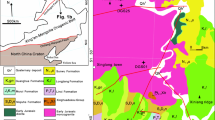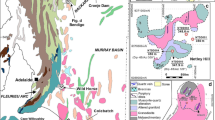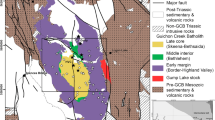Abstract
Trace elements in magmatic zircon exhibit characteristic trends during magma compositional evolution. Zircon geochemistry presents the advantage over whole rock geochemistry of showing progressive ‘snapshots’ of accompanying melt chemistry during magma crystallization, and in situ methods such as LA-ICPMS and SIMS can provide multiple analyses in zoned zircons for higher resolution of magmatic processes. However, one limitation is that zircon is typically a late-crystallizing phase, leaving much of the magmatic history unrecorded. Using the CAMECA ims1290 ion microprobe with Hyperion-II ion source, we explore whether micro-zircon (ca. 5–40 µm) captured by relatively early-crystallizing magmatic accessory minerals can meaningfully enhance the interpretations of zircon trace element records of magmatic evolution in two granites from Southern California: the La Posta 2-mica granite and the granite of Butler Peak (Big Bear Lake Intrusive Suite). We find that contamination of the inclusion measurement by major structural constituents of the host phase is a problem for most measurements, but that species which are not structural components of the host phases follow typical magmatic zircon trace element evolution trends. Compared to free grains from a mineral separate, zircon inclusions in ilmenite and apatite from the La Posta 2-mica granite are on average lower in Hf, recording plausible extensions of these magmatic evolution trends to earlier periods in magma evolution. Free zircons from the granite of Butler Peak’s mineral separate form a more complex story, recording both mixing between Cretaceous magmas derived from different depths (based on their U/Yb and Eu/Eu* behavior) and inheritance of older Mesozoic to Proterozoic zircon. Most zircon inclusions in Butler Peak magnetite and ilmenite are chemically like the apparently shallow magma-derived Cretaceous zircons in the free matrix, while a small proportion of the included zircon resemble more closely the apparently deeper magma or the inherited grains.
Similar content being viewed by others
Data Availability
All geochemical data generated during this study are available in the article and its supplemental online materials.
References
Barth AP, Wooden JL, Mueller PA, Economos RC (2016) Granite provenance and intrusion in arcs: Evidence from diverse zircon types in big bear lake intrusive suite, USA. Lithos 246:261–278
Bell EA, Kirkpatrick HM (2021) Effects of crustal assimilation and magma mixing on zircon trace element relationships across the Peninsular Ranges Batholith. Chem Geol 586:120616
Bell EA, Boehnke P, Hopkins-Wielicki MD, Harrison TM (2015) Distinguishing primary and secondary inclusion assemblages in Jack Hills zircons. Lithos 234:15–26
Bell EA, Boehnke P, Harrison TM (2016) Recovering the primary geochemistry of Jack Hills zircons through quantitative estimates of chemical alteration. Geochim Cosmochim Acta 191:187–202
Bell EA, Boehnke P, Harrison TM, Wielicki MM (2018) Mineral inclusion assemblage and detrital zircon provenance. Chem Geol 477:151–160
Bell EA, Boehnke P, Barboni M, Harrison TM (2019) Tracking chemical alteration in magmatic zircon using rare earth element abundances. Chem Geol 510:56–71
Bell EA, Kirkpatrick HM, Harrison TM (2022) Crystallization order effects on inclusion assemblages in magmatic accessory minerals and implications for the detrital record. Chem Geol 613:121143
Bloch EM, Jollands MC, Tollan P, Plane F, Bouvier AS, Hervig R, Berry AJ, Zaubitzer C, Escrig S, Müntener O, Ibañez-Mejia M (2022) Diffusion anisotropy of Ti in zircon and implications for Ti-in-zircon thermometry. Earth Planet Sci Lett 578:117317
Boehnke P, Watson EB, Trail D, Harrison TM, Schmitt AK (2013) Zircon saturation re-revisited. Chem Geol 351:324–334
Burnham AD, Berry AJ (2017) Formation of Hadean granites by melting of igneous crust. Nat Geosci 10(6):457–461
Cherniak DJ, Watson EB (2007) Ti diffusion in zircon. Chem Geol 242:470–483
Cherniak DJ, Hanchar JM, Watson EB (1997) Rare-earth diffusion in zircon. Chem Geol 134(4):289–301
Claiborne LL, Miller CF, Wooden JL, Mazdab FK (2010) Trace element composition of igneous zircon: temporal, thermal, and compositional record of magmatic processes in the Spirit Mountain Batholith, Nevada. Contrib Mineral Petr 60:511–531
Clinkenbeard JP, Walawender MJ (1989) Mineralogy of the La Posta pluton: implications for the origin of zoned plutons in the eastern Peninsular Ranges batholith, southern and Baja California. Am Miner 74(11–12):1258–1269
Ferry JM, Watson EB (2007) New thermodynamic models and revised calibrations for the Ti-in-zircon and Zr-in-rutile thermometers. Contrib Miner Petrol 154(4):429–437
Green TH, Watson EB (1982) Crystallization of apatite in natural magmas under high pressure, hydrous conditions, with particular reference to ‘orogenic’rock series. Contrib Miner Petrol 79(1):96–105
Harrison TM, Watson EB (1984) The behavior of apatite during crustal anatexis: equilibrium and kinetic considerations. Geochim Cosmochim Acta 48(7):1467–1477
Hoskin PW (2005) Trace-element composition of hydrothermal zircon and the alteration of Hadean zircon from the Jack Hills. Australia Geochimica Et Cosmochimica Acta 69(3):637–648
Jennings CW, Gutierrez CI (2010) Geologic map of California. California Department of Conservation, California Geological Survey, Sacramento, CA, USA
Keppler H, Wyllie PJ (1991) Partitioning of Cu, Sn, Mo, W, U, and Th between melt and aqueous fluid in the systems haplogranite-H2O−HCl and haplogranite-H2O−HF. Contrib Miner Petrol 109(2):139–150. https://doi.org/10.1007/BF00306474
Kirkland CL, Smithies RH, Taylor RJM, Evans N, McDonald B (2015) Zircon Th/U ratios in magmatic environs. Lithos 212:397–414
Kirkpatrick H, Harrison TM, Bell EA, Liu M-C, Tissot F, MacLennan SA, Ibanez-Mejia M (2020) Are Zr stable isotopes tracking magmatic differentiation in the zoned La Posta pluton?, Abstract V032–0004 presented at 2020 Fall Meeting. AGU, San Francisco, CA
Langenheim VE, Vazquez JA, Schmidt KM, Guglielmo G, Sweetkind DS (2021) Influence of pre-existing structure on pluton emplacement and geomorphology: the Merrimac plutons, northern Sierra Nevada, California, USA. Geosphere 17(2):455–478
Langmuir D (1978) Uranium solution-mineral equilibria at low temperatures with applications to sedimentary ore deposits. Geochim Cosmochim Acta 42(6):547–569
Liu Y, Li XH, Li QL, Tang GQ, Yin QZ (2011) Precise U-Pb zircon dating at a scale of< 5 micron by the CAMECA 1280 SIMS using a Gaussian illumination probe. J Anal at Spectrom 26(4):845–851
Liu MC, McKeegan KD, Harrison TM, Jarzebinski G, Vltava L (2018) The Hyperion-II radio-frequency oxygen ion source on the UCLA ims1290 ion microprobe: beam characterization and applications in geochemistry and cosmochemistry. Int J Mass Spectrom 424:1–9
Marquardt M, Barboni M, Bell EA (2022) Exploring the geochemical, geochronologic, and thermal history of HED Meteorites using Zircon. LPI Contrib 2678:2420
Pichavant M, Montel JM, Richard LR (1992) Apatite solubility in peraluminous liquids: Experimental data and an extension of the Harrison-Watson model. Geochimica et Cosmochimica Acta 56(10):3855–3861
Rasmussen B, Fletcher IR, Muhling JR, Gregory CJ, Wilde SA (2011) Metamorphic replacement of mineral inclusions in detrital zircon from Jack Hills, Australia: implications for the Hadean Earth. Geology 39(12):1143–1146
Schmitt AK, Vazquez JA (2006) Alteration and remelting of nascent oceanic crust during continental rupture: Evidence from zircon geochemistry of rhyolites and xenoliths from the salton trough. Calif Earth Planet Sci Lett 252(3–4):260–274
Shankland TJ, Ander ME (1983) Electrical conductivity, temperatures, and fluids in the lower crust. J Geophy Res 88(B11):9475–9484
Stevens G, Villaros A, Moyen J-F (2007) Selective peritectic garnet entrainment as the origin of geochemical diversity in S-type granites. Geology 35(1):9–12. https://doi.org/10.1130/G22959A.1
Sverjensky DA, Lee N (2010) The great oxidation event and mineral diversification. Elements 6(1):31–36
Villaros A, Stevens G, Moyen J-F, Buick IS (2009) The trace element compositions of S-type granites: evidence for disequilibrium melting and accessory phase entrainment in the source. Contrib Miner Petrol 158(4):543–561. https://doi.org/10.1007/s00410-009-0396-3
Walawender MJ, Gastil RG, Clinkenbeard JP, McCormick WV, Eastman BG, Wemicke RS, Smith BM (1990) Origin and evolution of the zoned La Posta-type plutons, eastern Peninsular. Nat and Origin Cordilleran Magmatism 174:1
Wark DA, Watson EB (2006) TitaniQ: a titanium-in-quartz geothermometer. Contrib Miner Petrol. https://doi.org/10.1007/s00410-006-0132-1
Watson EB, Harrison TM (2005) Zircon thermometer reveals minimum melting conditions on earliest Earth. Science 308(5723):841–844
Wiedenbeck M, Hanchar JM, Peck WH, Sylvester P, Valley J, Whitehouse M, Zheng YF (2004) Further characterisation of the 91500 zircon crystal. Geostand Geoanal Res 28(1):9–39
Zhang Y, Ni H, Chen Y (2010) Diffusion data in silicate melts. Rev Mineral Geochem 72(1):311–408
Zhu Z, Campbell IH, Allen CM, Burnham AD (2020) S-type granites: their origin and distribution through time as determined from detrital zircons. Earth Planet Sci Lett 536:116140
Acknowledgements
We thank Ming-Chang Liu for assistance with ion probe measurements. Discussions with Melanie Barboni and Mark Harrison were very helpful in develo** the study. We thank Josh Rosera and an anonymous reviewer for comments which helped improve the manuscript, and Othmar Muntener for his editorial handling. The ion microprobe laboratory at UCLA is partially supported by a grant from NSF-EAR’s Instrumentation and Facilities Program (1734856).
Author information
Authors and Affiliations
Corresponding author
Additional information
Communicated by Othmar Müntener.
Publisher's Note
Springer Nature remains neutral with regard to jurisdictional claims in published maps and institutional affiliations.
Supplementary Information
Below is the link to the electronic supplementary material.
Rights and permissions
Springer Nature or its licensor (e.g. a society or other partner) holds exclusive rights to this article under a publishing agreement with the author(s) or other rightsholder(s); author self-archiving of the accepted manuscript version of this article is solely governed by the terms of such publishing agreement and applicable law.
About this article
Cite this article
Bell, E.A., Kirkpatrick, H.M. Micro-zircon inclusions in accessory minerals reveal more complete magma compositional evolution records. Contrib Mineral Petrol 177, 113 (2022). https://doi.org/10.1007/s00410-022-01979-6
Received:
Accepted:
Published:
DOI: https://doi.org/10.1007/s00410-022-01979-6











